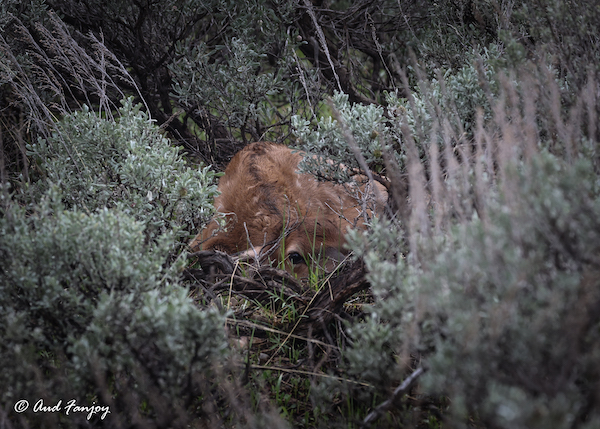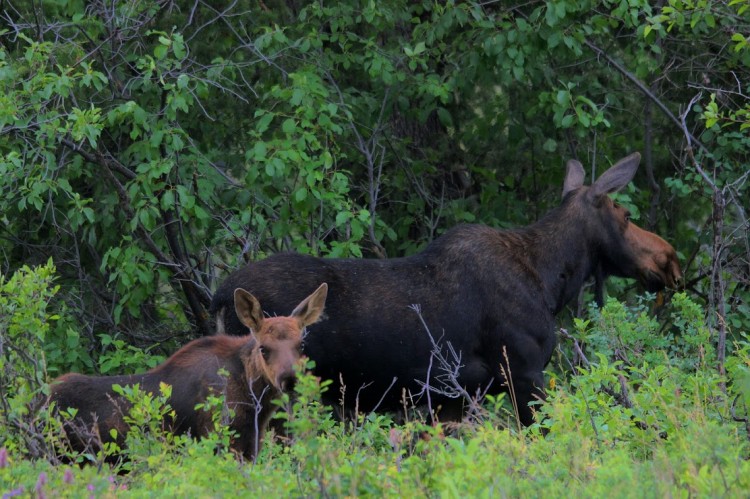The Baby Boom: Birthing Season in the Greater Yellowstone Ecosystem

Portions of this article are pulled from a 2016 blog post by Josh Metten on the same subject.
When spring awakens the land from its snowy slumber, a transformation occurs. Trees and shrubs sprout new leaves, flowers bloom, and new life in the form of baby critters joins the landscape. As temperatures warm and the snow melts away, the valleys and meadows of the Greater Yellowstone Ecosystem become a haven for expecting mothers, most notably our ungulate species–elk, moose, mule deer, bison, and pronghorn, in particular–who all give birth between early May and late June.
-7_copy.jpg)
An elk calf bedded amongst sagebrush. Photo by ETA Naturalist Audrey Fanjoy.
The mating season for all these species occurs around the same time–late summer into early fall–and they all have similar gestation periods, meaning these species also give birth around the same time. The timing of this is purposeful, and biologists have coined a term for it: mating synchrony. Births occur when the lush, green spring vegetation is at its highest protein and nutrient content, providing rich nourishment to mothers and their nursing young.
Mating synchrony serves an additional purpose: “flooding the market,” so to speak, with newborns, which reduces the overall number of young consumed by predators. Having slumbered all winter, grizzly and black bears emerge from hibernation having lost up to 30% of their body weight. It’s safe to say they have a voracious appetite. Female bears, called sows, need to feed not only themselves, but also one to three cubs (on average). Newborn ungulates provide an excellent food source for these and other predators. In their first few weeks of life elk, deer, moose, and pronghorn are too uncoordinated and slow to escape predators, making them an easy food source. As they grow, however, calves and fawns can soon outrun predators. Synchronizing births limits the overall number of animals that are preyed upon during this vulnerable time period, leading to a higher overall survivorship.

A cow moose and her calf.
In addition to this very specific timing, the young of prey species have developed specific physical adaptations to protect themselves. Elk calves and deer fawns are born with spots, which helps them to blend in on the forest floor when shafts of light are cast through the trees. Calves and fawns of all species discussed in this article are born without a scent, making them much harder for predators to sniff out. Not even a grizzly bear’s nose, which is seven times stronger than a bloodhound’s nose and 2,100 times stronger than a human’s nose, can smell them! Additionally, many fawns and calves, particularly elk and pronghorn, will hide themselves among thick vegetation until they are old enough to travel farther distances and run faster.
Bison are the only prey species that cannot hide, due largely to their size and tendency to occupy habitat that is wide open and lacking in cover. A unique adaptation of bison is that calves are born a rusty-reddish color–the reason for the nickname “red dogs”–which helps the calves to camouflage themselves among their landscape. Predators are red-green colorblind, so they struggle to distinguish the red calf from the tall green grass it stands in. Should a predator approach a herd, the adult bison will surround the calves, with the largest adults protecting the edges or trailing behind if the herd decides to run.
These large, charismatic mammals are not the only species bringing new life into the GYE in the spring. Birds are nesting and incubating their eggs. Small mammals such as foxes and Uinta ground squirrels are giving birth. All around us, the landscape is lush with new life–from baby animals to vibrant, verdant vegetation. Spring truly is a magical time to explore the GYE. Water from melting snows nourishes over 1,200 species of plants, who in turn feed an array of insects, birds, mammals and other organisms. The GYE is one of the most biologically temperate ecosystems on earth, and each change in the seasons offers new sights, sounds, and life to explore in this incredible place.













